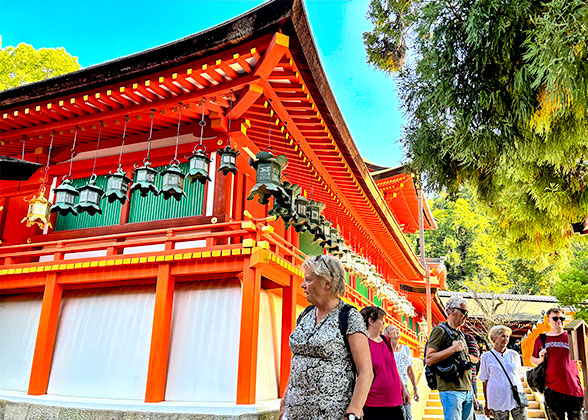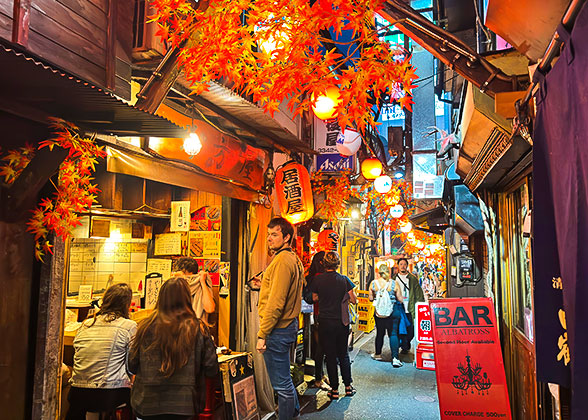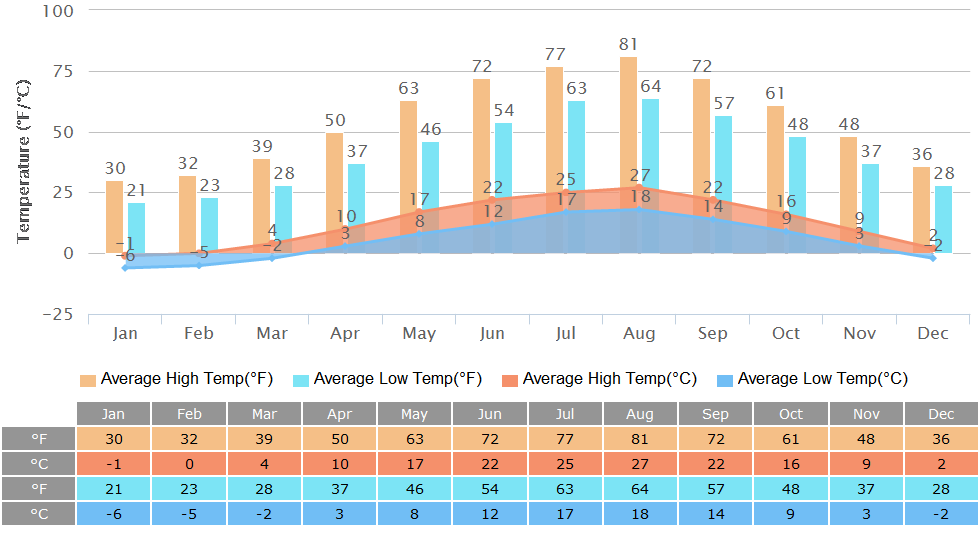Hirosaki Weather
Hirosaki is very humid all year round, with slowly warming spring from March to May, moderately hot and rainy summer from June to August, cooler and cooler autumn from September to November, and cold winter with frequent snowfall from December to February.Temperature
Located at the northernmost part of Honshu in Japan, Hirosaki’s climate is cooler year-round compared with other cities in Honshu, with a large annual temperature range of about 30 degrees Celsius (86 degrees Fahrenheit).
August is regarded as the warmest month in Hirosaki, with maximum temperatures remaining at 26-30℃ (79-86℉) mostly. There can be several days with temperatures reaching as high as approximately 32℃ (90℉), but scarcely exceeding 35℃ (95℉). The low temperatures are often at 16-22℃ (61-72℉). So, there are almost no extremely hot days and you will experience a temperate summer in your 2026 Hirosaki trip.
Hirosaki is shrouded in frigid air in January, with daytime temperatures rarely exceeding 6℃ (43℉), fluctuating mostly between -4 and 4℃ (25-39℉). Occasionally, the daytime temperature could drop below -6 ℃ (21℉). Nighttime temperatures are generally below 0℃ (32℉), with the lowest temperatures sometimes plummeting below -10℃ (14℉). Thus, if you plan to visit Hirosaki this month, you really need to take good precautions for warmth.
Precipitation
The annual precipitation is high, totaling 2,356 mm. In terms of frequency from high to low, it is winter, summer, autumn, and spring in sequence; but with regard to the amount, the order is winter, autumn, summer, and spring. Among four seasons, summer is more likely to experience several moderate or heavy rainfalls; besides, mid-June to mid-July belongs to the rainy season. Winter is mainly characterized by heavy snowfall.
Yes. Hirosaki experiences snowfall for about six months of the year. The first snow in Hirosaki usually occurs in mid-November. Onwards from December to February of the following year, there is frequent snowfall, with at least 20 snowy days each month, and the snowfall is often heavy, with the snow depth reaching over 1 meter (39 inches). The rich snowfall makes Hirosaki a world of ice and snow. In early spring in March, there are still an average of 16 snowy days, but the snow accumulations gradually melt as time progresses. By early April, there may be occasional light snowfall, but it melts quickly upon falling down.
Humidity
High humidity runs throughout the whole year due to heavy snowfall in winter and early spring, and constant rainfall in summer and autumn. Comparatively speaking, April and May are slightly less humid than others months.
Humidity Graph of Hirosaki
Best Time to Visit Hirosaki
The best time to visit Hirosaki is April to early November. During this period, the weather is pleasant overall, neither too hot nor too cold. Although summer and autumn is prone to rain, the precipitation is not high, meaning scarce impact on your trip. Particularly, you can enjoy beautiful natural landscapes such as cherry blossoms in full bloom from late April to early May and colorful autumn foliage from mid-October to early November, respectively.
Read more about Best Time to Visit Japan & Japan Weather
Hirosaki Climate by Season & Travel Advice
Spring: March-May
March is still very cold, with daytime temperatures mostly below 10℃ (50℉) and nighttime temperatures below 0℃. Coupled with the tendency for snow, you’ll need thermal inner layers and down jackets, along with thermal underpants, thick fleece trousers, and waterproof snow boots to keep warm.From mid-April onwards, the weather slowly warms up, and cherry blossoms in places like the Hirosaki Park, Hirosaki Castle and along the river banks of Shunyo Bridge begin to bloom. You can then wear lighter spring clothing, such as a sweatshirt and a wool coat, to enjoy the scenery and take beautiful photos. However, the blooming period here is relatively short, as Sakura generally wither after early May once temperature rises above 20℃ (68℉).
Summer: June-August
The temperature from June to mid-July is very mild, with daytime temperatures around 20-25℃ (68-77℉), so a light sweatshirt or a long-sleeved shirt is sufficient. Early mornings and evenings are very cool, between 12-20℃ (53.6-68℉), so adding a light jacket would be better. While the temperature from late July to August may make you feel a bit hot, it won’t be very high, so you won’t feel sticky; a T-shirt and summer pants will suffice.Summer in Hirosaki is lush and vibrant, with long hours of sunshine, perfect for a city walk. However, frequent rain during this season means it’s best to bring rain gear when hanging out. If it interferes with your outdoor experience, consider indoor attractions like the Aomori Bank Museum and Tsugaru-han Neputa-mura Village.
If you go there in early August, you can catch the Nebuta Festival, the oldest and most spectacular festival in Hirosaki. A grand parade takes place at night, with performers pushing floats adorned with beautifully decorated Nebuta lanterns and playing taiko drums and flutes, bringing you an immersive experience of local folk culture.
Autumn: September-November
In early to mid-September, the lingering warmth of late summer remains, so summer clothes should be sufficient. However, it’s still advisable to bring a light jacket in case of sudden temperature drops due to rain.From the latter half of the month, the weather gradually cools, with daytime temperatures transitioning from around 25℃ to around 15℃ (59℉) by early November. Noticeably, mornings and evenings get from cool to cold. It’s recommended that you bring clothing of varying thicknesses, such as shirts, sweaters, windbreakers, and 3-in-1 jackets, to adapt to the changing temperature. During this balmy period, the autumn scenery is particularly beautiful, especially in Hirosaki Park, Hirosaki Castle, and the Zenringai, where the ginkgo and maple leaves have transformed into mesmerizing colors to welcome your arrival! Furthermore, the chrysanthemum art exhibition will be held in Hirosaki Castle Botanical Garden, offering you picturesque views in every corner.
In mid to late November, the weather becomes significantly colder, with daytime temperatures generally fluctuating around 4℃, while nighttime temperatures can sometimes drop below 0℃. Therefore, down jackets and thick thermal pants are essential.
Winter: December-February
Winter is frigid overall, with the maximum temperatures under 4℃ mostly. In January and February, the minimum temperatures often drop below freezing point. Therefore, down coat and winter pants with thick linings are needed. Most of all, you’d better prepare high boots that are waterproof since heavy snowfall is very common, accumulating on the ground.For winter travelers, the Hirosaki Castle Snow Lantern Festival is highly recommended. Held annually in early February, the festival transforms the world into a magical winter wonderland with hundreds of snow lanterns, snow huts, and snow sculptures. If you’ve missed it in 2025, why not have fun in 2026!
It’s important to note that heavy snow can cause traffic problems, so it’s best to check the local weather-related information in advance and ensure that your trip is weather-permitted.
You May Like
-
 8 Days Mini Group Tour to Tokyo - Hakone & Mt. Fuji - Kyoto - Nara - Osaka – Hiroshima... from USD2771
8 Days Mini Group Tour to Tokyo - Hakone & Mt. Fuji - Kyoto - Nara - Osaka – Hiroshima... from USD2771 -
 11 Days Mini Group Tour to Tokyo - Hakone (Mt. Fuji) - Kyoto - Nara - Osaka – Hiroshima... from USD3554
11 Days Mini Group Tour to Tokyo - Hakone (Mt. Fuji) - Kyoto - Nara - Osaka – Hiroshima... from USD3554 -
 10 Days Private Tour of Tokyo - Mt. Fuji - Tokyo - Nagoya - Takayama - Shirakawa-go... from USD3756
10 Days Private Tour of Tokyo - Mt. Fuji - Tokyo - Nagoya - Takayama - Shirakawa-go... from USD3756



